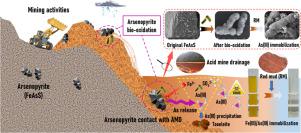Water Research ( IF 11.4 ) Pub Date : 2022-08-10 , DOI: 10.1016/j.watres.2022.118957 Hong-Rui Chen 1 , Duo-Rui Zhang 1 , Qian Li 1 , Zhen-Yuan Nie 1 , Eva Pakostova 2

|
Mining activities expose sulfidic minerals including arsenopyrite (FeAsS) to acid mine drainage (AMD). The subsequent release of toxic arsenic (As) can have great negative implications for the environment and human health. This study investigated the evolution of secondary products and As speciation transformations during arsenopyrite bio-oxidation in AMD collected from a polymetallic mine. Immobilization of the As solubilized via arsenopyrite bio-oxidation using red mud (RM) was also studied. The results show that the high ionic strength (concentrations of dissolved Fe3+, SO42−, and Ca2+ reached values up to 0.75, 3.38, and 0.35 g/L, respectively) and redox potential (up to +621 mV) of AMD (caused primarily by Fe3+) enhanced the dissolution of arsenopyrite. A high [Fe]aq/[As]aq ratio in the AMD favored the precipitation of tooeleite during arsenopyrite bio-oxidation, and the formation of other poorly crystalline products such as schwertmannite and amorphous ferric arsenate also contributed to As immobilization. Bacterial cells served as important nucleation sites for the precipitation of mineral phases. Arsenopyrite completely dissolved after 12 days of bio-oxidation in AMD and the [As]aq (mainly present as As(III)) reached 1.92 g/L, while a greater [As]aq was observed in a basal salts medium (BSM) assay (reaching 3.02 g/L). An RM addition significantly promoted As(III) immobilization, with final [As(III)]aq decreasing to 0.16 and 1.43 g/L in AMD and BSM assays respectively. No oxidation of As(III) was detected during the immobilization process. These findings can help predict As release from arsenopyrite on contact with AMD and, on a broader scale, assist in designing remediation and treatment strategies to mitigate As contamination in mining.
中文翻译:

酸性矿山排水中毒砂生物氧化所释放的 As 的释放和命运:As/Fe/S 形态和 As(III) 固定的重要性
采矿活动将包括毒砂 (FeAsS) 在内的硫化矿物暴露在酸性矿山排水 (AMD) 中。随后释放的有毒砷 (As) 会对环境和人类健康产生重大负面影响。本研究调查了从多金属矿采集的 AMD 中毒砂生物氧化过程中次级产物的演变和 As 形态转化。还研究了使用赤泥 (RM) 通过毒砂生物氧化溶解的 As 的固定化。结果表明,高离子强度(溶解的 Fe 3+、SO 4 2-和 Ca 2+的浓度分别高达 0.75、3.38 和 0.35 g/L)和氧化还原电位(高达 +621 mV ) 的 AMD(主要由 Fe 3+引起) 促进毒砂的溶解。AMD 中的高 [Fe] aq / [As] aq比率有利于毒砂生物氧化过程中钛白云石的沉淀,其他结晶度差的产物(如施韦特曼石和无定形砷酸铁)的形成也有助于 As 的固定。细菌细胞是矿物相沉淀的重要成核位点。毒砂在 AMD 中生物氧化 12 天后完全溶解,[As] aq (主要以 As(III) 形式存在)达到 1.92 g/L,而在基础盐培养基 (BSM) 中观察到更大的 [As] aq化验(达到 3.02 g/L)。添加 RM 显着促进 As(III) 的固定化,最终 [As(III)] aq在 AMD 和 BSM 测定中分别降至 0.16 和 1.43 g/L。在固定化过程中没有检测到 As(III) 的氧化。这些发现可以帮助预测与 AMD 接触时毒砂中的砷释放,并在更广泛的范围内帮助设计补救和处理策略以减轻采矿中的砷污染。











































 京公网安备 11010802027423号
京公网安备 11010802027423号